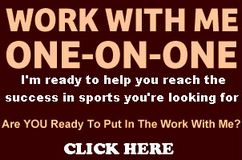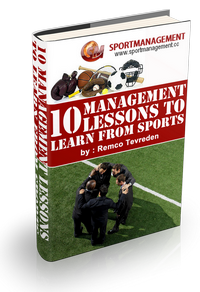Sponsorship - The sales process
We may not realize it, but most of our activities in our sport organization have something to do with selling. And you may have noticed that the ones, who are good in (verbal) communication, will also have the most success in selling their ideas to others.
Now before we analyze the general sales process, let’s look at some situations in sports, that clearly relate to selling.
Trainer – Athlete/Parents
A trainer has a technical trainings program, and wants his/her athletes to follow this plan as accurate as possible. Leadership capabilities are of big influence, but it comes down on how this program is being sold to the athletes. In some cases the parents also need to “buy” into the program of the trainer, as they may need special nutrition, sleeping hours or even training equipment.
Board/ management team
Every sports organization (for profit or not) has a board, or a management team who oversees the general management, the competitions, finances and other projects. Whenever one of the members of this team has an idea, they will need to bring this to the table. The one with the proposal will then try to sell the idea to the others.
Sponsorships
During the moments that sport organizations target companies for sponsorship, it also basically is the start of a selling process. Sometimes unfortunately, sport organizations position themselves as an underdog. This results automatically in a low negotiation power. The challenge for the sport organization is to identify their product (or service) that they want to sell to the company.
The process of selling has a basic structure, but it should be clear that the product or service focused on, depends on the “client” (athlete or company). In other words: the trainer uses other reasons for the athlete to buy the program, than the sports manager who targets a company for sponsorship.
Let’s apply the different phases to the process of sponsorship in sports. We assume hereby that the product or service is already clear. Generally speaking the selling process consists out of the following four phases.
1. Prospecting
What companies are you targeting, and why? Make sure that you identify the different business sector (banking, telecommunication, apparel), and that you target more than one competitor in the same business sector. Once you’ve identified prospects, you will want to learn all you can before you approach them. Contacting each prospect takes a lot of time and energy so look at each potential prospect carefully to see whether they are already sponsoring other sports organizations.
2. Initial Contact
In marketing there is the old “ Rule of Seven”. It says that a prospect needs to see or hear your “message” at least seven times before they take action and buy from you. Now whether the number 7 is exact or not… the message here is that you shouldn’t expect companies to accept your sponsorship proposal the first time you contact them. On the other hand, it is not to be advised neither to approach a company seven times with your same sponsorship proposal.
You should therefore make sure that the director, CEO or marketing manager of the company hears or sees in different ways about your sports organization or athletes. You can do this with flyers, social media or other creative ways.
3. Sales Presentation
Once you have an appointment with a company to elaborate on your proposal, you basically have come already a long way! The fact that they want to see your face and dedicate time to listen to you is a very positive sign. You should prepare this meeting or “sales presentation” very good, and know exactly what you are going to say. How much time do you have? Are you bringing a video or a PowerPoint presentation?
Don’t make the mistake of only talking, but listen well in the beginning to what the representatives of the company say. I advise anyone to bring along 1 or 2 athletes who have good communication skills. Let them talk about why they practice the specific sports, and how the company would help their development by becoming a sponsor.
4. Handling Objections
Companies will always doubt whether they should sponsor or not, so don’t be surprised if they seem hesitant. What you should do, is make a list of 10 possible objections the company might have, and how you would respond to these?
The most common objection is that the company doesn’t have sufficient funds to sponsor. Do you back down? Or do you ask what amount they are thinking of, or perhaps you could come back next year?
5. Closing the Sale
This is an important step. It would be expected that after the meeting, the company asks for some more time to think on the sponsorship proposal, which is fine.
But ask if you can call them within a couple of days or a week, to inform whether they have more questions. By being proactive and a bit aggressive (not too much!), you show them that you mean business!
6. Follow-Up
From this point there is the chance that the company decided not to sponsor. This doesn’t mean though that you shouldn’t try again next year. Make sure that you stay in close contact with this prospect, and keep sending them positive information about your sports organization.
If on the other hand the sponsor decided to agree with the sponsorship, then the process of follow up starts. In the next short period you should have close contact with the sponsor, to setup the sponsorship agreement, and maybe adjust some aspects in their favor. Don’t hesitate to give them a little bit more than the initial offer had. So “overperform” and to show “quality and professionalism”. You will then get your sponsors satisfied, which in the long run will give you loyal sponsors.
|
Like what you read?
If so, please join our sports community who receive exclusive Sport Management tips, and get a FREE COPY of my eBook, "10 Management Lessons to Learn from Sports"!
Just enter your name and email below:
|

|
One Comment
Trackbacks/Pingbacks
- Leadership Qualities List - Leadership Qualities List... [...]Sponsorship - The sales process | Sponsorship in Sports[...]...



am new to this thanks. thanks